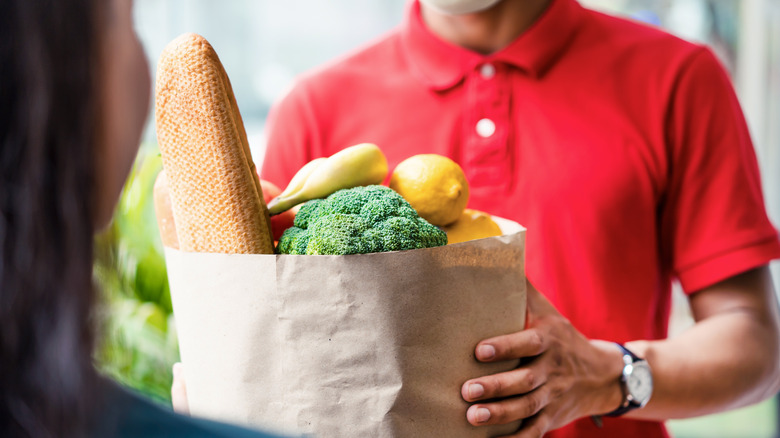Online Grocery Orders Are Increasing In Popularity Despite Inflation
The way people think about grocery shopping has significantly changed during the last few years. When in-store grocery shopping was majorly rocked during the pandemic, enter grocery delivery: the new convenient (and, for a time, essential) star of the supermarket. Soon, more grocery delivery services like Gorlliaz and Instacart began cropping up. According to The United States Census Bureau, e-commerce sales increased by 43% from 2019 to 2020 as a result of the pandemic. Even the word "grocery" itself has changed meaning over the years.
In 2022, as social restrictions ease, folks are heading back to the supermarket again — or at least they were. A recent Morning Consult survey found that 80% of shoppers reported feeling comfortable returning to in-store shopping as of October 2021. Yet, the U.S. Consumer Price Index (CPI) inflation rose 9.6% in June 2022, up from 8.6% in May (per Forbes), making grocery shopping pricier than ever. Now, a new press release by grocery analytics platform Brick Meets Click reports that, despite inflation, online grocery orders are increasing in popularity.
According to the press release, online grocery sales in the U.S. saw $7.2 billion in sales in June 2022 alone — a 6% increase from the same time period last year. As more grocery delivery service options have cropped up, overall monthly delivery sales rose by over 20% in June for 6% year-over-year increase. In fact, delivery services accounted for 34.2% of all online grocery sale dollars in Q2 2022. So, what's the reason for the popularity shift?
Why today's consumers are moving online
Stepping from a lockdown world into one of high inflation has changed the reality for today's consumers. Brick Meets Click partner David Bishop explains the impact of these conflicting motivations: "Inflation and COVID are creating cross-currents in the market as higher prices motivate customers to look for ways to avoid paying more than necessary, and ongoing concerns about contracting the virus motivate shoppers to use online grocery as a way to stay healthy," per the press release. Sylvain Perrier, CEO of investment data management platform Mercatus, agrees. Perrier says that, despite rising inflation, "Customers crave convenience, but they also want to find ways to save money."
However, these might not be the only reasons people opt for online grocery services anymore. Last month, retail data analytics platform dunnhumby reported that U.S. online grocery shoppers are likely to spend 1.5 times more on groceries than in-store shoppers but are also 10% more likely to have difficulty converging financial expenses, via a press release on Business Wire. The results, it says, are likely impacted by the fact that online grocery shopping is easier for families — despite the newly higher price point. Grant Steadman, President for North America at dunnhumby, says, "This indicates an evolution from the orthodoxy that the online and omnichannel shoppers value convenience above all and are not price sensitive. This study suggests that is not always the case."

